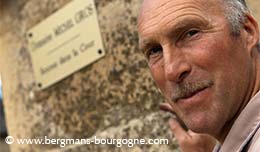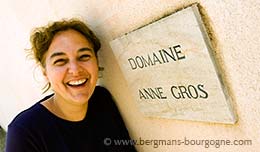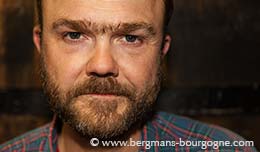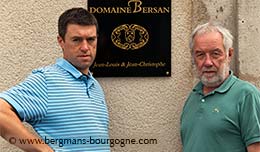
fter seven centuries Domaine Yvon Clerget in Pommard took a short break in 2009. There was a gap when one generation retired, while the new generation was still undergoing training. In 2015 Thibaud Clerget returned home for his first vintage. Since then he has spent a decade realising his plans for the family domaine. Along the way he has also bought a whole domaine in order to add vineyards to the existing portfolio.
– I knew which style of wine I was going for, he explains. I taste a lot with my colleagues. I’m open-minded, so I had a good idea of what I wanted to do. My first vintage was 2015. Today I am much more familiar with the vineyards, the soil and the wines. Over the years I have developed a little bit with each vintage. For example, since 2019 I don’t do pigeage anymore. Before I did it a lot, but not anymore.
 The first harvest at Domaine Clerget was in 1268. 28 generations later Thibaud Clerget is busy redefining the domaine. But there was a time when he favoured golf courses over vineyards, and things might have turned out quite differently.
The first harvest at Domaine Clerget was in 1268. 28 generations later Thibaud Clerget is busy redefining the domaine. But there was a time when he favoured golf courses over vineyards, and things might have turned out quite differently.
– I was good at golf when I was 15-16 years old. I was on the French golf tour and I wanted to attend a golf school in order to take it further. My father was OK with that, but I grew up among the vineyards and I found it difficult to leave the region. Now I am very happy with my choice.
Thibaud Clerget has been fine-tuning his approach to the vineyards and the wines of the domaine. Along the way some routines have been changed, others have been kept.
 – It takes a lot of time to really understand each terroir, he says. A lot. A very good example is the Volnay premier cru, Les Santenots. For me it is the most masculine wine in Volnay. The soil consists of 80 per cent clay. It is the toughest terroir in Volnay and I had problems with the tannins which were quite hard. It wasn’t an elegant wine. Since 2019 I have stopped the pigeage and I’m using about 20 per cent whole bunches, and the wine has lots finesse now. It was the same thing with the Clos de Vougeot. It was very difficult and in 2017 I started using whole bunches, and it turned out really well.
– It takes a lot of time to really understand each terroir, he says. A lot. A very good example is the Volnay premier cru, Les Santenots. For me it is the most masculine wine in Volnay. The soil consists of 80 per cent clay. It is the toughest terroir in Volnay and I had problems with the tannins which were quite hard. It wasn’t an elegant wine. Since 2019 I have stopped the pigeage and I’m using about 20 per cent whole bunches, and the wine has lots finesse now. It was the same thing with the Clos de Vougeot. It was very difficult and in 2017 I started using whole bunches, and it turned out really well.
 Since Yvon Clerget retired before his son arrived at the domaine Thibaud Clerget never worked with his father.
Since Yvon Clerget retired before his son arrived at the domaine Thibaud Clerget never worked with his father.
– When he stepped down in 2009 I came here for the vinification, but I never really worked with him. One could say that the style of my father was rather old school, Thibaud Clerget says. It was wines that needed 10-15 years before they could be drunk. Very long élevage. The style and methods have all changed since then. My father used to harvest by machine. I stopped that. All vineyards are ploughed now and I switched to organic farming in 2018. The vines are trained higher, a metre and a half.
– I am not certified organic. It is something I do for me and my clients. If I one day need to use a product to save my harvest I will do that. My yields are low and I can’t afford to lose a harvest. My aim is 30 hl/ha. In 2021 it was 10 hl/ha and in 2020 25 hl/ha.
 Domaine Yvon Clerget is a predominantly red domaine. And despite being located in Pommard there is a strong focus on the Volnay appellation. There is very little white and the only village appellation white of the domaine, the Meursault Les Chevalières, has been uprooted and replanted. The first vintage from the young vines will be in 2026.
Domaine Yvon Clerget is a predominantly red domaine. And despite being located in Pommard there is a strong focus on the Volnay appellation. There is very little white and the only village appellation white of the domaine, the Meursault Les Chevalières, has been uprooted and replanted. The first vintage from the young vines will be in 2026.
The Bourgogne rouge is a blend of two parcels – Les Durots in Meursault and Les Longbois in Volnay. It is 100 per cent de-stemmed and no new oak, just barrels that are two, three or four years old.
 – The Volnay premier cru, Carelle sous la Chapelle, is always the last to be harvested, says Thibaud Clerget. It’s high in alcohol, it’s a ”sunny” wine. Like the Bourgogne rouge it is 100 per cent de-stemmed, but it gets 20 per cent new oak.
– The Volnay premier cru, Carelle sous la Chapelle, is always the last to be harvested, says Thibaud Clerget. It’s high in alcohol, it’s a ”sunny” wine. Like the Bourgogne rouge it is 100 per cent de-stemmed, but it gets 20 per cent new oak.
As the name suggests, Carelle sous la Chapelle, is just below the chapel in Volnay, just below the D973 road. The soil is mainly clay, with a little bit of limestone.
– I also have Les Mitans, which is another premier cru right next to Carelle sous la Chapelle. They are two very different vineyards. There is more clay in Carelle sous la Chapelle and more limestone in Les Mitans.
 Domaine Yvon Clerget boast one monopole, the Volnay premier cru Clos du Verseuil. It’s not very far from the chapel, Les Mitans and Carelle sous la Chapelle. It’s just across the D973 road, slightly higher up on the slope.
Domaine Yvon Clerget boast one monopole, the Volnay premier cru Clos du Verseuil. It’s not very far from the chapel, Les Mitans and Carelle sous la Chapelle. It’s just across the D973 road, slightly higher up on the slope.
– It’s really where you enter the village, says Thibaud Clerget. The Clos du Verseuil is a very interesting terroir. I have dug a large hole in order to analyse the soil together with a geologist from Perpignan. There is clay. It is very silty. Lots of crushed limestone. It’s very well drained, so the roots go very deep. The geologist has been working with Domaine de la Romanée-Conti and many other domaines and he says soil here is very similar to Echézeaux.
The Clos du Verseuil is 100 per cent de-stemmed and 30 per cent new oak is used. Since it’s a monopole – Domaine Yvon Clerget is the sole owner of the clos – there are no other bottlings to compare with.
 – Yes, says Thibaud Clerget, in that respect it is very different from Volnay Santenots for example, where you have many different owners. I swap bottles with Dominique Lafon (Domaine des Comtes Lafon), who has his Santenots mid-slope. My parcel is at the bottom of the slope, so you have two very different terroirs. At the bottom there is a lot of clay, whereas higher up you have more limestone and it is close to Les Caillerets. So it’s interesting to compare the two.
– Yes, says Thibaud Clerget, in that respect it is very different from Volnay Santenots for example, where you have many different owners. I swap bottles with Dominique Lafon (Domaine des Comtes Lafon), who has his Santenots mid-slope. My parcel is at the bottom of the slope, so you have two very different terroirs. At the bottom there is a lot of clay, whereas higher up you have more limestone and it is close to Les Caillerets. So it’s interesting to compare the two.
 – When it comes to Clos du Verseuil you could compare it with Clos de l’Audignac, which is right next to it and belongs to Domaine de la Pousse d’Or. But it is a little bit higher up and not at all the same soil. Also, Clos de l’Audignac gets an hour and a half less sun during the day because of the hill, so it doesn’t get the same ripeness. It’s a wine which is a bit ”cooler”, one could say.
– When it comes to Clos du Verseuil you could compare it with Clos de l’Audignac, which is right next to it and belongs to Domaine de la Pousse d’Or. But it is a little bit higher up and not at all the same soil. Also, Clos de l’Audignac gets an hour and a half less sun during the day because of the hill, so it doesn’t get the same ripeness. It’s a wine which is a bit ”cooler”, one could say.
 Les Rugiens is the only Pommard premier cru at Domaine Yvon Clerget. Thibaud Clerget points out that most people think of Les Rugiens as a wine which needs at least 10-15 years before it is ready to drink.
Les Rugiens is the only Pommard premier cru at Domaine Yvon Clerget. Thibaud Clerget points out that most people think of Les Rugiens as a wine which needs at least 10-15 years before it is ready to drink.
– I’m doing something which is quite different, he says. I guess you could call it Volnay style. Les Rugiens is there, you can taste it, but there is the fineness of a Volnay because I don’t extract heavily.
The only grand cru of the domaine is also the only wine from the Côte de Nuits. There is 0.32 ha plot of Clos de Vougeot, which came from Yvon Clerget’s uncle Félix Clerget in 1991. It is in the Grand Maupertuis part just below Grands-Echézeaux, with Domaine Laurent Roumier and Maison Ambroise as neighbours.
– It’s 50 percent whole bunches and 50 per cent new oak. With the Clos de Vougeot you have a completely different terroir and you can taste it. For me that’s very important, that you treat each terroir in a way that you really bring out its character. Each vinification is different.
When Thibaud Clerget arrived at the domaine in 2015 it covered six hectares. In 2022 another four hectares were added when he took on a large part of Domaine Régis Rossignol-Changarnier in Volnay. The remaining part went to Domaine Arnaud Baillot in Meursault.
– I bought the vineyards in July 2022, explains Thibaud Clerget. It was thanks to the chef de culture of their domaine. He came to me asking if I was interested in hiring him. I asked why and he told me the domaine was up for sale. So I made an offer.
The acquisition brought Bourgogne rouge and blanc, as well as Bourgogne Aligoté, to the domaine. In Pommard a bit of Les Chanlins and in Volnay some Les Ppetits Poisots, together with two premier crus, Clos des Angles and Les Brouillards.
© 2025 Ola Bergman














